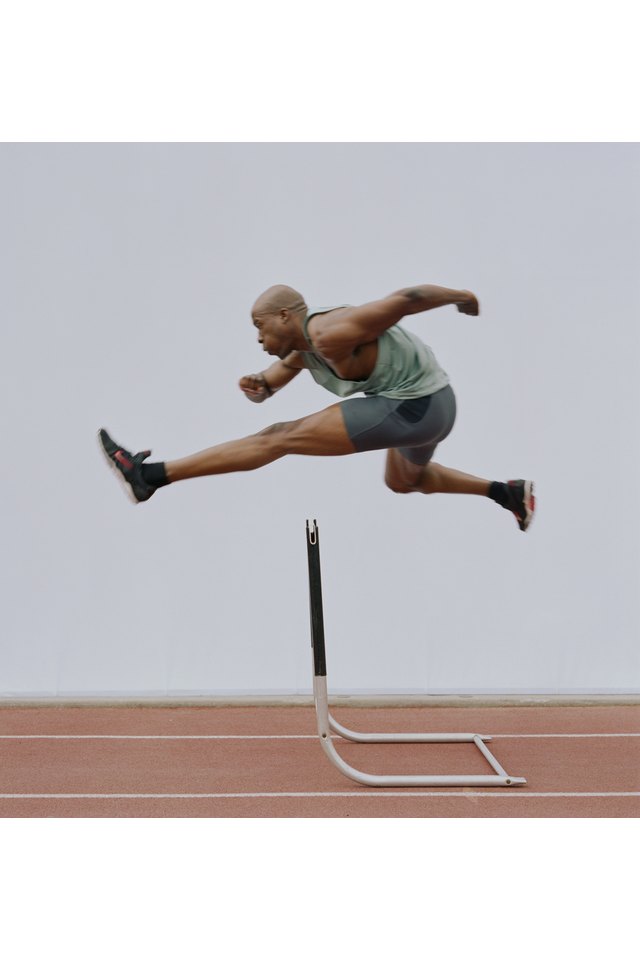Fast-Twitch & Slow-Twitch Muscles in Vertical Jumping

Vertical jumping is a tough sport to learn, as it requires your muscles to be able to contract quickly and explosively in order to obtain the maximum height possible. Fitness trainers say that the difference in the number of fast-twitch and slow-twitch muscles that you have can determine how good you are at vertical jumping. However, specialized training can help your vertical jump no matter what ratio of muscle fibers you have.
Muscle Types
Muscle fibers are generally categorized into two types: fast twitch and slow twitch. Fast-twitch muscles work anaerobically (without oxygen), and slow-twitch muscles work aerobically, according to Michael Chaturantabut, an Olympic gold medalist and three-time World and five-time North American martial arts champion. Fast-twitch muscles generate energy quickly, but they also fatigue quickly. Slow-twitch muscles are slower to gather force, but they also take longer to tire out, according to Mike Kaza, a world-class high-jumper and creator of a 12-week vertical jump exercise program.
Jumping Benefit
Fast-twitch muscles, because of their ability to generate quick energy, are the best muscles for vertical jumping. People who have a greater percentage of fast-twitch muscles tend to be naturally better at vertical jumps. Fast-twitch muscles are further broken down into two types: type IIa and type IIb. Type IIb produce the most force, but also fatigue the fastest. These Type IIb fibers help with vertical jumps the most, although type IIa fibers also play a role.
Plyometrics
Plyometrics is a type of training that focuses on the movements that help the most with vertical jumping, Chaturantabut writes on his website. Plyometrics focuses on quickly contracting a muscle right after it's stretched in order to generate a greater force. This exercise only trains fast-twitch muscles. An example of plyometics training is depth jumping: jumping from an elevated surface, landing with both feet and immediately jumping onto another platform. Consult an athletic coach before beginning this training, as it can cause injuries if not done correctly.
Strength Training
Eccentric-enhanced strength training is a type of weight training that focuses specifically on fast-twitch muscles in order to improve vertical jumping abilities, according to Charles Poliquin, an Olympic trainer. This exercise is also beneficial to elderly adults. Eccentric training is the lowering part of a weight lift, such as when you lower your arm in a bicep curl. In eccentric-focused training, you only lift half of your maximum weight, and while you do the raising part of the weight lifting with both arms simultaneously, you do the lowering part one arm at a time and at a slower pace. Consult a trainer or athletic coach to make sure you're doing eccentric training correctly.
References
- Zierath JR, Hawley JA. Skeletal muscle fiber type: influence on contractile and metabolic properties. PLoS Biol. 2004;2(10):e348. doi:10.1371/journal.pbio.0020348
- Clark M, Lucett S, Sutton BG. NASM Essentials of Personal Fitness Training 4th edition revised. Philadelphia: Wolters Kluwer Health/Lippincott Williams & Wilkins; 2014.
- Powers SK, Howley ET. Exercise Physiology: Theory and Application to Fitness and Performance. New York: McGraw-Hill Higher Education; 2012.
Writer Bio
With features published by media such as Business Week and Fox News, Stephanie Dube Dwilson is an accomplished writer with a law degree and a master's in science and technology journalism. She has written for law firms, public relations and marketing agencies, science and technology websites, and business magazines.
